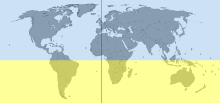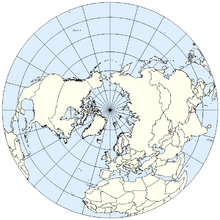Northern Hemisphere
This article needs additional citations for verification. (November 2018) |
Coordinates: 90°0′0″N 0°0′0″E / 90.00000°N 0.00000°E


The Northern Hemisphere is the half of the Earth that is north of the Equator. For other planets in the Solar System, north is defined as being in the same celestial hemisphere relative to the invariable plane of the solar system as Earth's North Pole.[1]
Owing to the Earth's axial tilt of 23.439281°, winter in the Northern Hemisphere lasts from the December solstice (typically December 21 UTC) to the March equinox (typically March 20 UTC), while summer lasts from the June solstice through to the September equinox (typically on 23 September UTC). The dates vary each year due to the difference between the calendar year and the astronomical year. Within the northern hemisphere, oceanic currents can change the weather patterns that affect many factors within the north coast. Such events include ENSO (El Niño-Southern Oscillation).
Trade winds blow from east to west just above the equator. The winds pull surface water with them, creating currents, which flow westward due to the Coriolis effect. The currents then bend to the right, heading north. At about 30 degrees north latitude, a different set of winds, the westerlies, push the currents back to the east, producing a closed clockwise loop.[2]
Its surface is 60.7% water, compared with 80.9% water in the case of the Southern Hemisphere, and it contains 67.3% of Earth's land.[3] Europe and North America are entirely on Earth's Northern Hemisphere.
Geography and climate[]
The Arctic is a region around the North Pole (90° latitude). Its climate is characterized by cold winters and cool summers. Precipitation mostly comes in the form of snow. Areas inside the Arctic Circle (66°34′ latitude) experience some days in summer when the Sun never sets, and some days during the winter when it never rises. The duration of these phases varies from one day for locations right on the Arctic Circle to several months near the Pole, which is the middle of the Northern Hemisphere.
Between the Arctic Circle and the Tropic of Cancer (23°26′ latitude) lies the Northern temperate zone. The changes in these regions between summer and winter are generally mild, rather than extreme hot or cold. However, a temperate climate can have very unpredictable weather.
Tropical regions (between the Tropic of Cancer and the Equator, 0° latitude) are generally hot all year round and tend to experience a rainy season during the summer months, and a dry season during the winter months.
In the Northern Hemisphere, objects moving across or above the surface of the Earth tend to turn to the right because of the Coriolis effect. As a result, large-scale horizontal flows of air or water tend to form clockwise-turning gyres.[4] These are best seen in ocean circulation patterns in the North Atlantic and North Pacific oceans.[citation needed] Within the northern hemisphere, oceanic currents can change the weather patterns that affect many factors within the north coast; such as El Niño.[citation needed]
For the same reason, flows of air down toward the northern surface of the Earth tend to spread across the surface in a clockwise pattern. Thus, clockwise air circulation is characteristic of high pressure weather cells in the Northern Hemisphere. Conversely, air rising from the northern surface of the Earth (creating a region of low pressure) tends to draw air toward it in a counter-clockwise pattern. Hurricanes and tropical storms (massive low-pressure systems) spin counter-clockwise in the Northern Hemisphere.[5]
The shadow of a sundial moves clockwise on latitudes north of the subsolar point. During the day on these latitudes, the Sun tends to rise to its maximum at a southerly position. Between the Tropic of Cancer and the Equator, the sun can be seen to the north, directly overhead, or to the south at noon dependent on the time of year. In the Southern Hemisphere, the midday Sun is predominantly at the north.
When viewed from the Northern Hemisphere, the Moon appears inverted compared to a view from the Southern Hemisphere.[6][7] The North Pole faces away from the galactic center of the Milky Way. This results in the Milky Way being sparser and dimmer in the Northern Hemisphere compared to the Southern Hemisphere, making the Northern Hemisphere more suitable for deep-space observation, as it is not "blinded" by the Milky Way.[citation needed]
Demographics[]
The Northern Hemisphere is home to approximately 6.40 billion people which is around 87.0% of the earth's total human population of 7.36 billion people.[8][9][10]
See also[]
- Arctic Ocean
- North–South divide (disambiguation)
References[]
- ^ Archinal, Brent A.; A'Hearn, Michael F.; Bowell, Edward G.; Conrad, Albert R.; Consolmagno, Guy J.; et al. (2010). "Report of the IAU Working Group on Cartographic Coordinates and Rotational Elements: 2009" (PDF). Celestial Mechanics and Dynamical Astronomy. 109 (2): 101–135. Bibcode:2011CeMDA.109..101A. doi:10.1007/s10569-010-9320-4. S2CID 189842666. Archived from the original (PDF) on 2016-03-04. Retrieved 2018-09-26.
- ^ Society, National Geographic (2019-07-01). "Ocean Currents". National Geographic Society. Retrieved 2020-10-16.
- ^ Life on Earth: A - G.. 1. ABC-CLIO. 2002. p. 528. ISBN 9781576072868. Retrieved 8 September 2016.
- ^ US Department of Commerce, National Oceanic and Atmospheric Administration. "Boundary Currents - Currents: NOAA's National Ocean Service Education". oceanservice.noaa.gov. Retrieved 2020-07-31.
- ^ "Hurricanes: Science and Society: Primary Circulation". www.hurricanescience.org. Retrieved 2021-08-11.
- ^ Laura Spitler. "Does the Moon look different in the northern and southern hemispheres? (Beginner) - Curious About Astronomy? Ask an Astronomer". cornell.edu. Retrieved 10 November 2015.
- ^ "Perspective of the Moon from the Northern and Southern Hemispheres". Archived from the original on 9 September 2017. Retrieved 22 October 2013.
- ^ Calculated from World Population Yearbook 2019(in thousands) World total population: 7,359,970 Northern hemisphere population: 6,405,030 87.0% Southern Hemisphere population: 954,940 13.0% Note 1) If there is no data for 2019, the latest data was used. Note 2) Countries with land that straddles the equator are divided into half populations in each of the northern and southern hemispheres.
- ^ "90% Of People Live In The Northern Hemisphere - Business Insider". Business Insider. 4 May 2012. Retrieved 10 November 2015.
- ^ "GIC - Article". galegroup.com. Retrieved 10 November 2015.
External links[]
![]() Media related to Northern Hemisphere at Wikimedia Commons
Media related to Northern Hemisphere at Wikimedia Commons
- Northern Hemisphere
- Hemispheres of Earth
